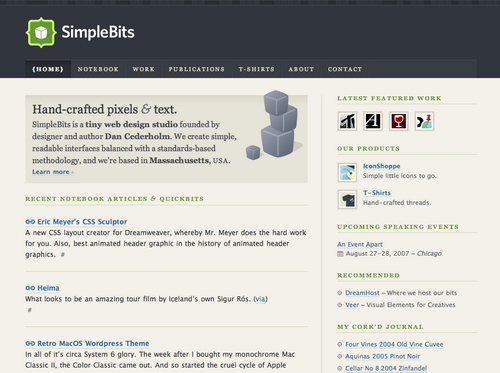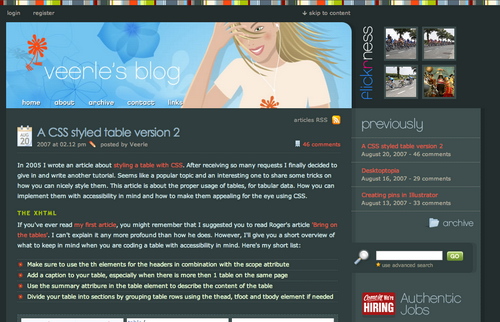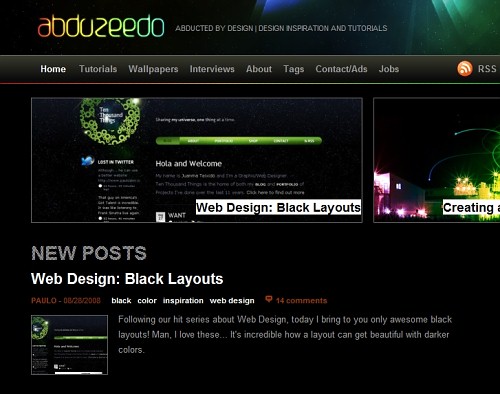10 Weblog Engines Reviewed
Choosing blogging software can be a scary process, especially if you are new to blogging. There are many different types of engines and content management systems (CMS) that could be used. Picking the software that you’ll need is not an easy task, given the wide variety and types on the Web today.
There are many different aspects to consider when choosing which blogging software to pick. For instance:
- Programming language. Many blog platforms run on either PHP or Rails, but you can find just about any flavor of programming language you are looking for.
- What features you’ll need. The type of software you might choose is very dependent on the type of blog you are going to run. Some blog software is geared more towards new users, while others are more developer and designer-friendly. It’s a matter of finding software based on the features you need.
- The size of the software’s community. If the software community is larger for one blogging system and much smaller and less active than another, the more active community is usually a better choice for software. More active users within the development community means more improvements on the code base, in a faster time frame.
- The age of the software. The age of the software shows the maturity of the blogging platform. Young projects are more unstable, and are more likely to have bugs.
- If you are planning on extending the blog. If you are thinking about adding things like forums, a store, or some other feature to your blog, some blogging software will be more suited to fill that need than others.
The blog software that you choose can have a big impact on your blogging. It’s important to choose the right software in the very beginning, so you can avoid the hassle of migrating to different engine later on. Here are the pros and cons of the 10 most popular blogging systems.
You may want to take a look at these newer related articles:
- How WordPress Took The CMS Crown From Drupal And Joomla
- Why Static Website Generators Are The Next Big Thing
- 10 Things To Consider When Choosing The Perfect CMS
- Build A Blog With Jekyll And GitHub Pages
1. Wordpress
Wordpress is the most famous and widely-used blogging platform. It features a very intuitive web-based installer so anyone from skill level novice to expert can quickly install the software without any hiccups.
The Wordpress community is a major asset to the blogging software. It has one of the largest and most passionate communities of developers and users, so one could find just about any theme or plugin imaginable. The possibilities for extending the software are endless, and many web sites and services have used the Wordpress code base to build entirely different applications. Wordpress also features integration with Akismet, one of the most effective spam protection systems for blogging software.

Wordpress makes it easy for new bloggers to not only install the software, but also to download and install automatic upgrades to plugins with only one click. The learning curve for Wordpress is fairly minimal, and if a new user runs in to problems, they can always check the extensive documentation. Wordpress is perfect for the new blogger who wants to get his feet wet installing their first blog software, or the advanced developer who’s looking to extend the stable code into something entirely different.
Sites powered by Wordpress
Web Designer Wall

I Love Typography

Binary Moon

Superflous Banter

2. Movable Type
While Wordpress is the most widely-adopted blogging platform, Movable Type has the most prolific installs of high-traffic blogs. Their high-profile installs include (and certainly aren’t limited to) Huffington Post (the most popular blog on the Web), Gawker blogs (Lifehacker, Gizmodo, etc.), BoingBoing and dooce.

A major reason for so many high-profile sites using Movable Type is the built-in support for multiple blogs running on one install. You can quickly create as many blogs as you wish, creating blog networks like Huffington Post and Gawker instantly.
While Moveable Type has historically been a step behind Wordpress in terms user friendliness, Movable Type has made great strides to improve their interface and installer, and possibly the biggest step forward recently was moving the platform to open source. This has grown the community considerably.
Movable Type is a great choice if you are wanting to run multiple blogs or a blog network with the software that can handle large amounts of traffic.
Sites powered by Movable Type
Kevin Kornell

Cameron Moll

Dave Shea

Dan Cederholm

3. ExpressionEngine
ExpressionEngine is a very robust blogging platform, but isn’t free. The best feature about ExpressionEngine is the feature to publish multiple websites, either using different subdomains on a single domain, or across multiple domains.
You could use one code base to power multiple sites across multiple domains. The software features an extremely clean and simple backend that shouldn’t confuse the blogger. Designers and developers love ExpressionEngine for the fact that it’s quite easy to hand over a site and have the client update his own blog. It’s a solid all-in-one package.

ExpressionEngine is really geared for people who are trying to start a multi-blog site, but anyone can use the software quite easily thanks to its thoughtful and elegant design. A single license costs $99.95, but if you’re running a personal blog you can download the core version of EE.
Sites powered by Expression Engine
Veerle Pieters

4. Drupal
Drupal isn’t your typical blogging software. While it has an incredible community behind the code and many blogs use it for blogging software, it’s not just blogging software. Drupal is community software.
Drupal really shines as blog software for a blogging community. Whether you are wanting to power one blog to a 100, Drupal is an excellent choice.

Another strong point about Drupal is the versatility of the software. It comes packaged with a robust user system, but also a lot of community-friendly features like forums, books (for creating documents in a “book” structure) and a tracker which allows you to follow updates and content that other users have published recently.
Drupal also comes with a large community of developers and modules. With these modules, one could build any type of site or add nearly any sort of functionality to their Drupal installation. Many top-notch sites use Drupal to publish their multiple blogs and user communities. Performancing, Spread Firefox, The Onion, and Ubuntu and others.
Drupal is the perfect blogging software for anyone wanting to add a community to their blog with forums and extensions.
Sites powered by Drupal
43 Folders
Abduzeedo

5. Textpattern
Textpattern is a much simpler blogging platform than any of the above mentioned software. It isn’t even packaged with a WYSIWYG editor, and instead relies on the Textile markup language to format the text.
Textpattern is very similar to ExpressionEngine, except without many of the features that ExpressionEngine provides out of the box. (You can read more about the differences between the two blog platforms.) While Textpattern is a stable, mature piece of software, it’s not the top choice for beginners, as they have to learn the Textile language or write posts in html. If they’re wanting to have a WYSIWYG editor, they’ll have to install the plugin, as it’s not provided by defaul.t

There are plenty of themes and extensions, and while the developer community isn’t as large as Wordpress’s, Textpattern has an extremely loyal and dedicated developer community.
Textpattern is a great choice for a more advanced blogger who appreciates simplicity and doesn’t mind learning Textile.
Sites powered by Textpattern
Hicksdesign
UX Magazine
NZRN
Erratic Wisdom

6. Joomla
Joomla is a CMS that is similar to the community-friendly Drupal, and gaining traction every day. While Drupal is geared more towards developing community-flavored sites and blogs, Joomla seems to be geared more towards ecommerce (you can read more about the comparison between Joomla and Drupal here).

Regardless of their differences, Joomla is very much like Drupal in the fact that it’s easy to get anything from a simple site to a community blog in minutes. Joomla has a vibrant development community which has created many extensions.
Joomla is perfect for anyone wanting to build a blogging community site, or add ecommerce functionality to a blog.
7. b2evolution
b2evolution is another blogging platform that allows for a single installation of a blog, or a whole network of blogs, right out of the box. b2 probably has the weakest developer community behind it, with only a 200+ plugins (compared to Joomla’s 3,400+).
While the b2 developer community may not be very large, it has a very promising code base and many people still use b2evolution to power their blogs and blogger communities.

The software features a very easy-to-understand backend, ideal for beginners. b2 also has has a built in stats feature, which is something most blogging platforms don’t have out of the box. The software also features a post editor with a very minimal WYSIWYG editor, which is perfect for a beginning blogger.
8. Nucleus CMS
Nucleus is yet another single or multi-blog/multi-author blogging software package. It is fairly comparable to b2evolution in terms of features and development community, and has a list of fairly extensive and useful plugins and themes that can be added to customize any installation.

Nucleus has a much more polished look and feel than b2evolution, and the backend area is simple and clean. Also, Nucleus has a much more active release schedule than b2, which means the code is more actively worked on. Here’s a demo site if you are wanting to play around with the software before trying to download it.
Nucleus is a great blog platform for anyone needing a straightforward blogging platform for one or more blogs.
9. Serendipity
Serendipity takes pride in the fact that it is a beginner-friendly blogging platform. Serendipity keeps your plugins up-to-date by automatically checking the plugin repository online and downloading the updated version if needed from a fairly extensive library of user-contributed plugins. The software also features nested and threaded commenting, which many blog platforms don’t support without a plugin of some sort.

Serendipity uses the high-performance Smarty templating system, and makes use of fast and clean PHP code under the hood. If you are a new blogger, Serendipity offers a setup wizard that makes blog installation a breeze. Unlike b2evolution or Nucleus, Serendipity doesn’t offer a multiple blogs with just one installation, but you can have multiple users to the single blog installation.
10. Mephisto
Up until this point, we haven’t even mentioned any blog software that runs on any other language other than PHP. Mephisto blogging software is blogging software built on Rails. Mephisto offers a very clean look to the backend, and has an intuitive feel to it. You can control every aspect of the look of Mephisto with the built-in template editor, without the help of FTP clients.

There isn’t much in terms of extra themes or plugins to help with customizing the blog’s layout or functionality. Mephisto is more of a bare-bones blogging software that up until recently hasn’t been developed too extensively.
Mephisto is more of a blogging platform for designers and web developers who are able to create their own themes and plugins to customize the site. Beginners might fare better trying Wordpress or Movable Type. These two popular blogging platforms make customization easier with all of the plugins and different themes offered.
Honorable Mentions
Here are a few blogging systems that weren’t included that deserve mentioning.
- Habari Habari is an up-and-coming modern blog platform that focuses on tackling at the core level many of the shortcomings that other blogging software communities have tried to address with add-ons. Habari prides itself in being standards compliant and more secure than other blogging platforms.
- Pixie Pixie is a small CMS that allows for fast creation of websites or blogs. It’s simple, easy to use, and free. It features a beautiful backend, with easy to understand navigation and layout.
Other Resources For Choosing Blogging Software
- Open Source CMS Open Source CMS allows you to actually try out the different types of blogging software without having to download and install anything. It’s a much like a blogging test drive. They host multiple platforms of blogging software, allowing you to see the frontend of the blog and nose around the admin area of the blogging system.
- Showcase of Wordpress-based sites
- Showcase of Expression Engine-based sites
- Showcase of Drupal-based sites
- Showcase of Textpattern-based sites



 Flexible CMS. Headless & API 1st
Flexible CMS. Headless & API 1st




